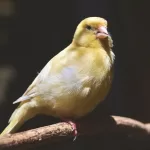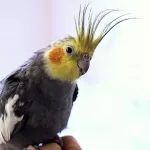Lovebird Care Guide

One of the smallest members of the parrot family, lovebirds–so named for the strong pair bonds they form–can make incredible companions. Learn all about Lovebird care here.
Lovebird Size:
At full maturity, a Lovebird will grow to between 5 and 7 inches tall and have a wingspan of up to 10 inches.
Lovebirds typically live about 15 years, however, some species will live between 20 and 30 years in captivity if well cared for.
Lovebird Care:

As their name implies, Lovebirds are highly social birds and will do better in pairs than alone. In the wild, they live in flocks, and in captivity, they best thrive when with other birds.
In general, these birds are well suited to captivity, making them hearty, excellent pet birds.
They have a gentle disposition and can be quite charming.
They’re also fairly easy to breed if that is your goal, and overall are relatively easy to care for compared to many other species.
As long as the lovebird is human handled from a young age they tend to be easy to tame and train and will thrive on interaction and attention from their human keepers.
Lovebird Diet:
In the wild Lovebirds eat a variety of seeds, fruits, berries, and vegetation. They will also feast on certain farm crops like corn, marking them as “pests” among farmers.
A balanced diet of seeds, greens, and the occasional sweet fruit treat (about 3 to 4 times per week), will work best. Lovebirds especially favor:
- Apples
- Bananas
- Papaya
- Melons
- Carrots
- cabbage
- Spinach
Lovebird Habitat:
Like always, we prefer cages that come with stands on castors to make them easy to move around while not being placed upon home furniture where they can cause damage to the finishes.
For lovebirds, you want to have plenty of space for them to move around and spread their wings inside and out.
Lovebird Behavior:
Lovebirds are highly social, of course, which some owners don’t always appreciate fully. Like at the break of dawn when Lovebirds wake and begin to chirp and sing. They’re doing this because they’re happy and content, but for the owner who wishes to sleep in a little longer, it can be annoying.
Lovebirds are also active and need free time outside of their cages to move and fly about.
You’ll also want to have plenty of wood perches for them to rest on and even gnaw upon.
And give them lots of toys to stimulate their curious minds and exercise their beaks and wings with.
Lovebird Care Conclusion:
Lovebirds are sturdy, low-maintenance pets that do best in pairs and can thrive with any owner, regardless of experience level, as long as they can put a little time into socializing the birds daily.
They’re bold, playful, curious, and active birds that will keep you entertained for hours. The various species offer a variety of beautiful colorings, like Fischer’s Lovebird for example, and despite the early morning activity most people find their chirping and singing to be pleasing and even relaxing.
You can go even deeper into the care and wellness of Lovebirds from a veterinarian’s perspective here.

Nicholas Burns – Veterinary Technician, amateur Ornithologist
Nick has volunteered at bird rescues since he was a teenager and worked as a veterinary technician for almost two decades. He has extensive experience with animal care and a special love for birds, especially his African Grey, Scrooge (who knows all the bad words!).





